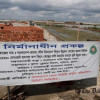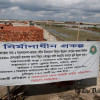Rampal Plant Pollution Impact: Greenpeace study shows grim picture
The Rampal power plant would cause at least 6,000 premature deaths and low birth weights of 24,000 babies during its 40-year life, a Greenpeace study said yesterday.
It said the plant, which would burn 5 million tonnes of coal every year, would be among the largest sources of air pollution in the country.
The emissions would elevate the levels of toxic particles, sulphur dioxide and nitrogen dioxide over the entire south-western Bangladesh and 100km to the northeast due to prevailing wind patterns.
The affected areas, due to wind patterns, would cover the entire Sundarbans ecosystem, Satkhira, Khulna, Noakhali, Comilla, Narsingdi and Dhaka districts in Bangladesh and Ashoknagar, Kalyangar, Basirhat and Kolkata of West Bengal, it said.
"Exposure to these pollutants increases the risk of diseases such as stroke, lung cancer, heart and respiratory diseases in adults, as well as respiratory symptoms in children," it said.
"This would happen even if Bangladesh currently had zero air pollution," said Lauri Myllyvirta, coal and air pollution specialist of Greenpeace, in a presentation via Skype from Myanmar.
The presentation was made at a press conference organised by National Committee to Protect the Sundarbans (NCPS), Bangladesh Paribesh Andolon (Bapa) and Doctors for Health and Environment (DHE) at the city's Dhaka Reporters Unity to unveil the study.
India's state-owned National Thermal Power Corporation and Bangladesh Power Development Board are constructing the 1,320 megawatt plant on 1,834 acres 14km north of Sundarbans, the world's largest mangrove forest, also a Unesco world heritage site.
Green groups have been opposing the power plant in Rampal of Bagerhat. The UN too urged Bangladesh to halt its construction near the Sundarbans, which acts as a natural barrier against cyclones.
The government, however, has been going ahead with the project, saying it was using the best technologies available to prevent any possible damage.
Contacted, Nasrul Hamid, state minister for power and energy , disagreed with the Greenpeace findings.
The plant would surely emit pollutants, but not as much as that could lead to the damage claimed by Greenpeace, he said.
"They [green activists] are not experts. They make claims as they wish. They don't study based on exactly what we are doing and how," Nasrul told The Daily Star over phone.
He said the government could not avoid coal-fired power plants. "We don't have options. We have to have mixed sources of power to make it affordable to people," he said, calling upon green activists to sit with the relevant government officials to get the "real picture".
Greenpeace said it conducted the study using the modelling systems recommended by the US Environmental Protection Agency (EPA) and World Health Organisation (WHO) in assessing long range transport of pollutants and results of their exposures. The methodology was not explained in details at the press conference yesterday. (Greenpeace study methodology)
Greenpeace expert Myllyvirta said the Rampal plant would increase the 24-hour average ambient levels of nitrogen dioxide in nearby localities up to 25 percent over the current national urban average, and sulphur oxide levels up to 50 percent over the urban average.
"Emission limits for sulphur dioxide, nitrogen oxides, dust and mercury, as specified in the tender documents, are five to 10 times higher than best regulatory practice and technical state-of-the-art emission levels," Greenpeace added.
The study said due to the high population density in the impact area and weak emission limits applied for the project, the estimated health impacts were 150 premature deaths and births of 600 low-weight babies per year.
Greenpeace said the predicted number of premature deaths would drop to 50 a year if the much stricter new Indian standards were followed. In the state-of-the art emission scenario, the premature death would further fall to 20 cases a year.
The plant could emit high levels of mercury, a potent neurotoxin that damages children's brains and nervous systems, and it could be sufficient to render fish unsafe to eat over an area of approximately 70 sqkm around the power plant.
Additionally, 10,000kg of mercury discharged over the life of the plant could end up in the coal ash pond, which is subject to flooding and poses further risks to aquatic food chain of the Sundarbans and Bay of Bengal. This could impact millions of people who eat those fish.
NCPS Convener and rights activist Sultana Kamal said the Greenpeace study speaks of a grim future of biodiversity and human health.
"Implementing the Rampal power project means pushing our future generation towards disabilities and premature death. This can't happen," she told journalists, and demanded cancellation of the plant project.
The former adviser to a caretaker government said they had repeatedly presented scientific data, but the authorities had been neglecting those saying green activists were not experts.
"This is not true. There are experts among us," she said.
"They [government] are not providing us with correct information. They are trying to justify the project through false propaganda," said Sultana, adding that the government was buying machinery based on quite old technology.
DHE President Nazmun Nahar said if mercury enters the eco-system and the food chain, it would cause mental disabilities in future generations.
The paediatrician said 48 percent children in Bangladesh were born with low weight, and they run higher risks of diabetes and heart diseases in their adulthood.
"If the Rampal plant causes birth of more low-weight babies, it would worsen public health," she said.
NCPS Member Secretary Abdul Matin, Joint Secretary Sharif Jamil of Bapa, and Prof Abu Sayeed also spoke at the press conference. 25412569874

 For all latest news, follow The Daily Star's Google News channel.
For all latest news, follow The Daily Star's Google News channel. 








Comments